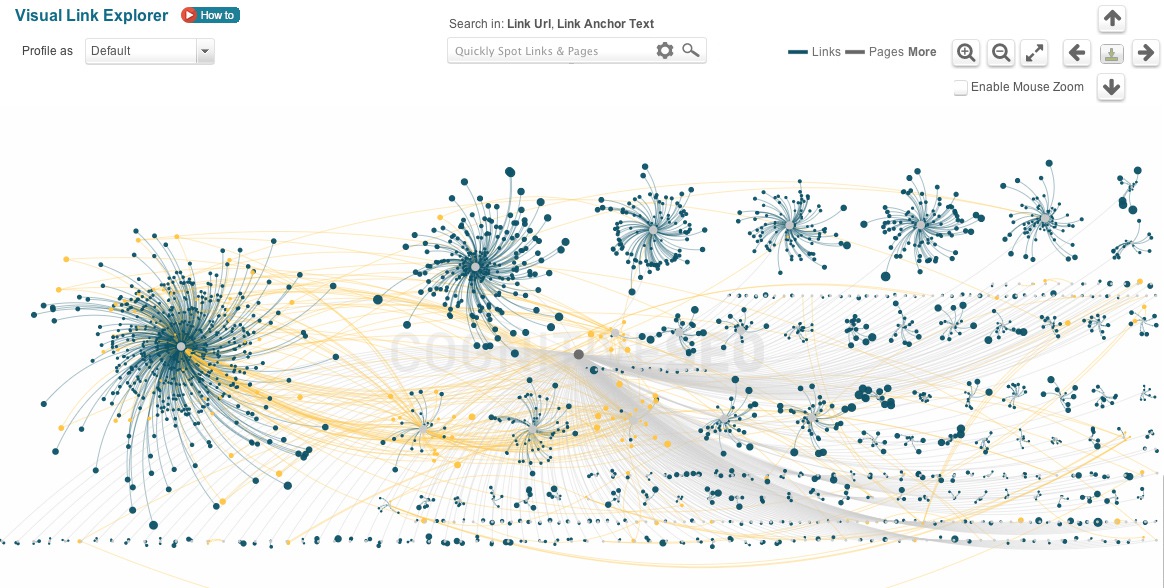Backlink audits are a must for every webmaster or SEO professional and are the first step to developing any link building plan. A backlink audit is an in-depth analysis that allows you to closely inspect elements related to the link building strategy of a site including unnatural links profile, competition analysis, etc. A link audit helps detect problems and opportunities for your website and should also be one of the first steps of developing a strong digital marketing strategy.
So, why is a backlink audit such an important part of the SEO puzzle? Owning this important “piece”allows you to get a clearer picture of the entire puzzle and better understanding why you, or your competitor, is ranking for a particular set of keywords.
Knowing to run and then read a backlink audit is utterly important nowadays, particularly when one of the key signals of the Google algorithm is the “link”.
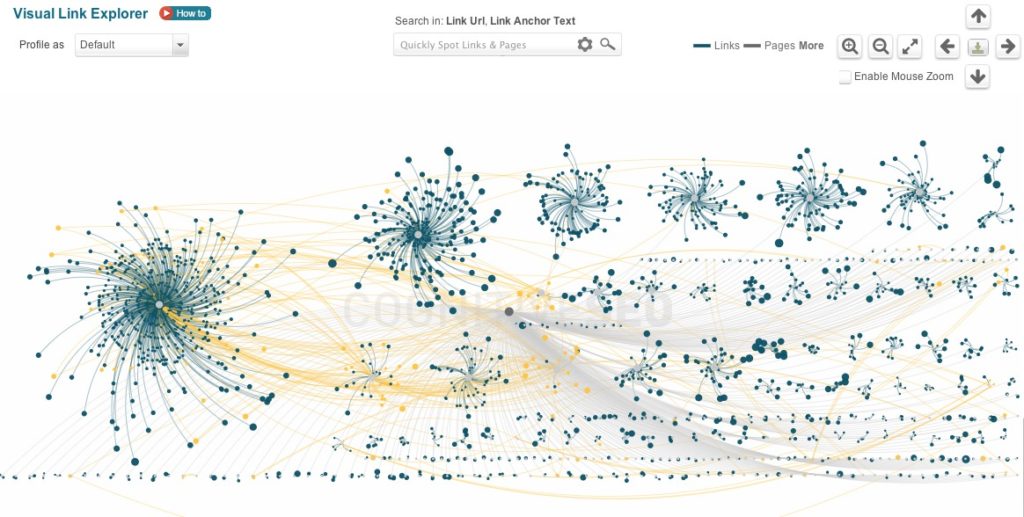 Screenshot taken 04/04/2014 of tools.cognitiveseo.com (I am the founder of cognitiveSEO)
Screenshot taken 04/04/2014 of tools.cognitiveseo.com (I am the founder of cognitiveSEO)When is a Backlink Audit Helpful?
Whenever you find yourself in one or more of the following situations:
- You are trying to develop or improve a link building strategy.
- You want to analyze the competition and have a clear view where the competition stands.
- You want to avoid a penalty.
- You want to recover from a penalty.
- You want to identify new opportunities for your link building strategy.
- You want to identify your competitive advantages and also your flaws.
- You want to understand the link building strategies your competitors are using.
- You want to pitch a potential client.
What You Should Look For in a Backlink Audit?
1. Referring Domains
I don’t know exactly how this “craving for links” started but one thing is for sure: many companies are working to build as many links as possible from any source possible. Which is a mistake. There is more value in higher quality links. Webmasters continue to count links instead of focusing on the referring domains.
[pullquote]When you try to unravel the “mystery” of a link profile, the number you should look at is the number of referring domains.[/pullquote]
Let’s say you are trying to see how two sites are doing from a link profile point of view:
- Site “A” has 100,000 links, coming from 10 referring domain.
- Site “B”, has 1,000 links coming from 100 referring domains.
Which one do you think is more popular in the SERPs?
Site “B” is surely doing better, even though it has 10 times less links. Why? It has 10 times more referring domains.
2. Google Penalty Risk Analysis
With constant changes in the online world, the Google Penalty Risk analysis should be on the mind of every web master. Whether you are trying to avoid a penalty or are striving to recover from one, a back link analysis is absolutely necessary. A continuous monitoring of your link profile will help you stay in control.
First, analyze how natural your link profile looks like. You need to permanently supervise the ratio between natural and unnatural links!
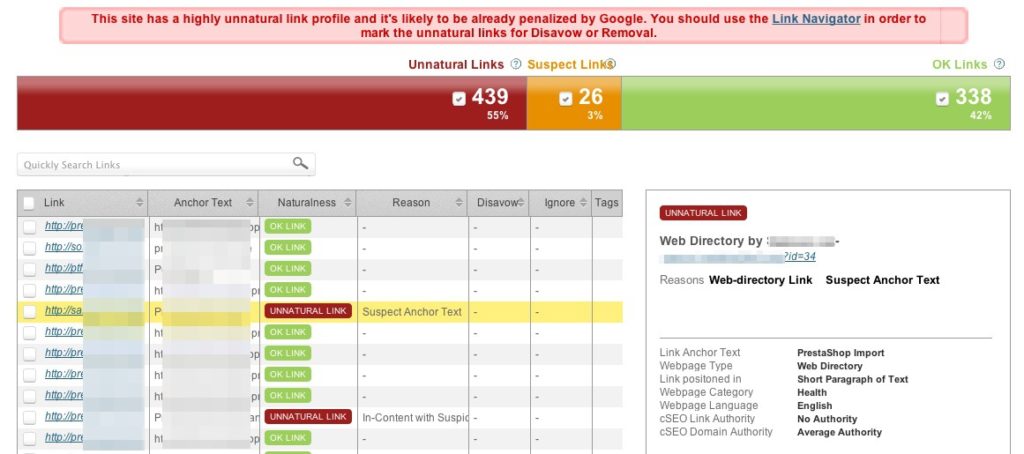 Screenshot taken 04/04/2014 of tools.cognitiveseo.com
Screenshot taken 04/04/2014 of tools.cognitiveseo.comIt is unlikely that a site’s profile will be 100% natural but, from our in-house case studies at cognitiveSEO, sites with over 20 percent unnatural and suspect links are at a high risk of being flagged by Google for bad linking practices.
Constantly monitoring your link profile provides you with vital information about your risk of being penalized by Google. Having an unnatural link profile doesn’t necessary mean you use shady tactics to manipulate the ranking. Negative SEO attacks could also influence the way a link profile looks like.
If you want to rank on the long-term in Google, it is highly recommended to closely follow Google’s Guidelines. Even so it is important to keep an eye on a potential penalty risk.
[pullquote]Monitoring the Unnatural Links Distribution allows you to avoid Google Penalties and also increases the changes of Google Recovery for penalized sites.[/pullquote]
3. Expose Used Link Building Strategies
Link building strategies are highly discussed, and with good reason: Link Building Strategies Actually Work.
A good link building strategy can offer you better rankings and. This is highly important for those who:
- Didn’t directly carry out their link strategy (they outsourced it) and want to fully understand how their site is standing.
- Already know the strategies used on their sites, but want to take a peek on their competitor’s plan of action.
Once the link building strategy is debunked, you can easily understand the tactics used and how that specific site was being linked to. You can see, for instance, whether links are coming from high quality blogs or if most of the links are actually from low authority web directories.
[pullquote]By running an in-depth link analysis, you can seize strategic problems of a link building campaign.[/pullquote]
These could lead to inefficiency or even penalties, but you could also spot great opportunities that could boost your rankings.
4. Link Velocity Analysis
Link velocity represents the growth trend of a sites’ link profile. We could easily define two link velocity directions:
- Unnatural Link Growth
- Natural Link Growth
If a natural link velocity depicts a balanced growth, an unnatural link velocity will have various spikes on various time frames:
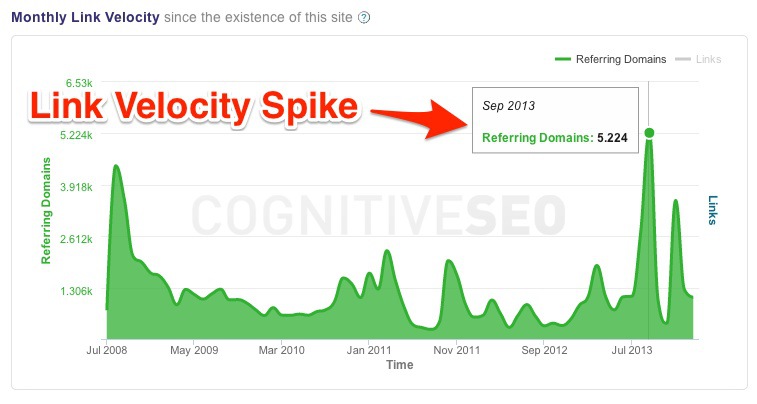 Screenshot taken 04/04/2014 of explorer.cognitiveseo.com
Screenshot taken 04/04/2014 of explorer.cognitiveseo.comThe link velocity analysis allows us to:
- Understand how links are created and the average speed of their “acquisition”.
- Identify spikes and analyze several periods of time in which peculiar things have happened.
- Analyze a site’s success or failure depending on people’s interest to link to that site.
- Foresee a penalty due to the identification of an unnatural link building strategy.
5. Anchor Text Analysis
The analysis of the anchor text distribution is a very important because it generates valuable information about a site’s linking strategy:
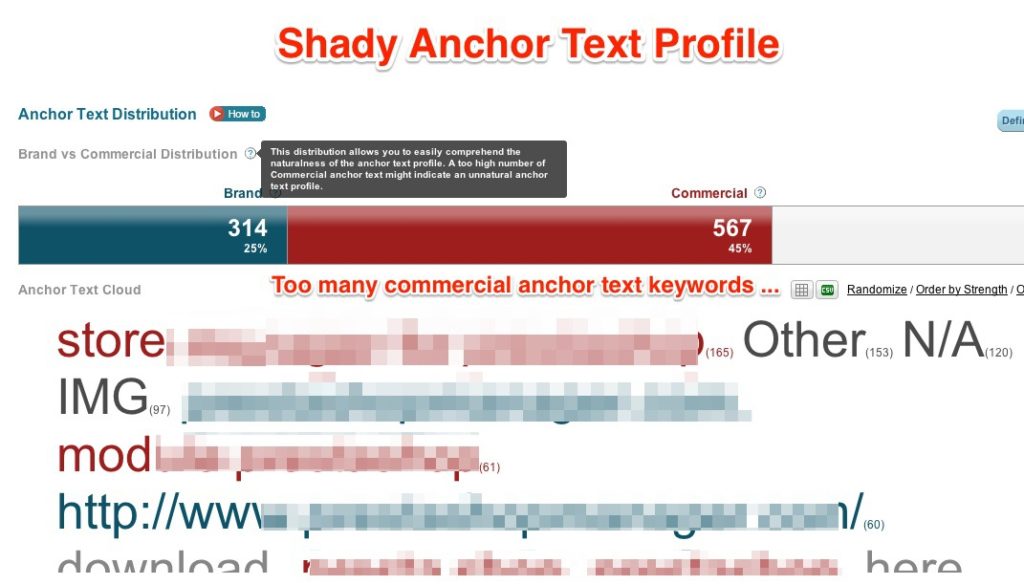 Screenshot taken 04/04/2014 of tools.cognitiveseo.com
Screenshot taken 04/04/2014 of tools.cognitiveseo.com- Helps you evaluate your current link building strategy and help you find out which keywords are more likely to achieve high-ranking
- It can help you understand how natural a site’s link profile is
- Understand how your audience links to your site
- Get an idea of your competitor’s link building strategy
For a normally distributed and natural anchor text profile, you should see many anchor texts containing “brand” or “miscellaneous” (navigational,etc) keywords and fewer commercial ones. Brand and commercial anchor text is one of the signals that Google takes in consideration when deciding if a site is trying to manipulate its results or not.
When there is a big percentage of commercial keywords, it is likely that a red flag will be raised and Google could potentially ban the site.
6. Identify Opportunities
Sometimes, the bigger the challenges, the greater the opportunities. A backlink audit can not just provide information about the present status but can also settle future action directions. The first step in identifying future actions for your company is establishing some key performance indicators (KPIs).
If you want to evaluate your strategies’ success, you need to set defined goals. Ask yourself what results you want to achieve and how are you going to measure them. Choosing the right KPIs relies upon a good understanding of what is important for your company. For instance, a college might consider the graduation rate of its student as a key performance while an online business might consider the number of conversions or unique visitors as a potential KPI. Once you know WHAT you want to accomplish you have to find HOW to achieve your goals, taking into consideration your actual link building strategy and the direction you want to head to.
Avoid Analysis Paralysis
You might be familiar with the term of analysis paralysis. It refers to spending far too much time on analyzing and way too little time on actually taking action. “Analysis paralysis” or “paralysis of analysis” occurs when over-analyzing and over-thinking is actually paralyzing the outcome.
[pullquote]Don’t over analyze irrelevant data.[/pullquote]
In an analysis paralysis situation occurs when the opportunity cost of decision analysis exceeds the benefits of enacting some decision. It’s sort of behavioral economics. A decision is endlessly postponed based on all sort of “grounded” excuses like: “Maybe the timing is not right”, “I don’t have all the data I need”, “I am not sure this is the right strategy; maybe we should do so more research”, etc.
I am not saying you should immediately jump right into a link building campaign without doing any research, but at a certain point, you have to stop analyzing and start taking action. You should also focus on the important stuff and not pay too much attention to ALL the small details in a link audit. Below are some tips that you can use in order to avoid the paralysis of your analysis:
1. Work With Deadlines
Strictly define a period of time for each step of the analysis. For instance, set a deadline for gathering data, one for analyzing it, a deadline for generating a list of possible directions of actions, etc. For this to work, you have to respect the deadlines and to accept that you will never have ALL the data about a particular subject and you’ll have to work based on what you have at that moment.
2. Collaborate With Others
Once you have an idea about what you want to do, ask for feedback from your colleagues. Their responses might help you advance with your work, can speed up the process of taking a decision and can give you some responses you’ve been looking for.
3. Abandon The Idea of “Perfection”
Accept the idea that there is no such thing as “perfect decision”; there is only the best decision that can be taken in a specific context.
4. Accept a Possible Failure
People are usually stuck in an analysis paralysis because of the fear of failure. The truth is over thinking will not relieve you of failure but it will rather invite the failure in. Although is hard to accept, you need to embrace the fact that failure is possible and even if it occurs, is not the end of the world.
Conclusion
In solving link puzzles, one of the biggest benefits is looking at the big picutre. Before you begin to solve the “link equation”, think of what kind of result you are looking for. Choose the important pieces first, put them together in a logical way and analyze them closely with an objective eye. Don’t get discouraged and remember: the art of simplicity is a puzzle of complexity.
Screenshot taken April 2014



